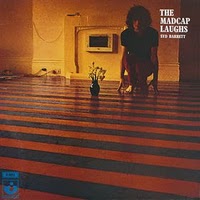 I have no idea what Syd Barrett’s mental state was like when he recorded this album (going on what I’ve read, though, it obviously wasn’t good), but we should emphasise this doesn’t sound like music from a man who was sick. It’s confident, playful (if also darker and more serious than his Floyd material), whimsical and open. It’s also not very “psychedelic”, in the sense that Piper was; the music, pared back to its core, reminds me more of, say, post-Cale Velvets than the Floyd. It’s an album with its own, defiantly personal way of doing things; it’s something you’ve never heard before, totally individual, and there’s no meeting it halfway — you either open your heart to it, or you don’t. Myself, I love it to pieces. –Brad
I have no idea what Syd Barrett’s mental state was like when he recorded this album (going on what I’ve read, though, it obviously wasn’t good), but we should emphasise this doesn’t sound like music from a man who was sick. It’s confident, playful (if also darker and more serious than his Floyd material), whimsical and open. It’s also not very “psychedelic”, in the sense that Piper was; the music, pared back to its core, reminds me more of, say, post-Cale Velvets than the Floyd. It’s an album with its own, defiantly personal way of doing things; it’s something you’ve never heard before, totally individual, and there’s no meeting it halfway — you either open your heart to it, or you don’t. Myself, I love it to pieces. –Brad
Psych and Prog
The Holy Modal Rounders “The Moray Eels Eat the Holy Modal Rounders” (1969)
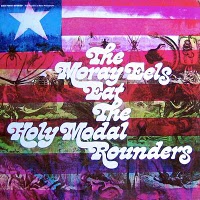 Acid folk? Nope. This is something far stranger: acid country-rock. Acid bluegrass, even. Basically it’s like someone took Live/Dead, Workingman’s Dead, American Beauty and Aoxomoxoa and decided to stick ’em in a blender, then play them all simultaneously, while smoking prodigious amounts of dope and running Easy Rider backwards so a bunch of dead hippies get brought back to life by rednecks with magic rifles. But better. –Brad
Acid folk? Nope. This is something far stranger: acid country-rock. Acid bluegrass, even. Basically it’s like someone took Live/Dead, Workingman’s Dead, American Beauty and Aoxomoxoa and decided to stick ’em in a blender, then play them all simultaneously, while smoking prodigious amounts of dope and running Easy Rider backwards so a bunch of dead hippies get brought back to life by rednecks with magic rifles. But better. –Brad
Circuit Rider “Circuit Rider” (1980)
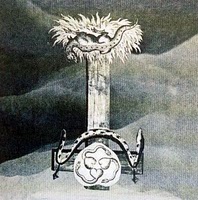 This private press pot of insanity from 1980 literally sounds like hell’s angels covering L.A. Woman. There’s no record label, the catalog number is 666, and it was maybe recorded in the early seventies, but no one really knows. Where did this come from? Connecticut actually, but it sounds a lot more like a deep swamp field recording. A lot of music sounds druggy, this one seems to top it all. The density of the haze within the grooves is thick enough to make you want to take a shower. At times it sounds like Funkadelic with no drums, at others it touches on more of a Canned Heat aesthetic, but always laced with heavy doses of lucid blanketing. The singer has some sort of biker/shaman/howling dog formula that, besides making the lizard king sound like Tom Jones in comparison, doesn’t bore the listener with cheesy trippy organ either. In fact the listener is way too frightened to be bored. It basically sounds like what you think of the sixties in your head, even when most actual sixties music sounds like the soundtrack to pictures of somebody’s goofy dad wearing bellbottoms. –Alex
This private press pot of insanity from 1980 literally sounds like hell’s angels covering L.A. Woman. There’s no record label, the catalog number is 666, and it was maybe recorded in the early seventies, but no one really knows. Where did this come from? Connecticut actually, but it sounds a lot more like a deep swamp field recording. A lot of music sounds druggy, this one seems to top it all. The density of the haze within the grooves is thick enough to make you want to take a shower. At times it sounds like Funkadelic with no drums, at others it touches on more of a Canned Heat aesthetic, but always laced with heavy doses of lucid blanketing. The singer has some sort of biker/shaman/howling dog formula that, besides making the lizard king sound like Tom Jones in comparison, doesn’t bore the listener with cheesy trippy organ either. In fact the listener is way too frightened to be bored. It basically sounds like what you think of the sixties in your head, even when most actual sixties music sounds like the soundtrack to pictures of somebody’s goofy dad wearing bellbottoms. –Alex
Frank Zappa “Freak Out!” (1966)
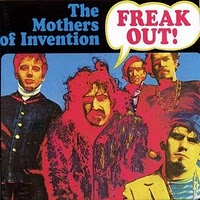 This is a true album for freaks. Back in 1967, Zappa must have felt left out of the hippy dippy counterculture because his musical interests seemed to extend beyond flowers in your hair, acoustic guitars and sitting barefoot in the park. So with this debut he in turn created a counterculture to the counterculture – an album for all the freaks and “left behinds” as he refers to them in the opening track Hungry Freaks Daddy. The music is frequently upbeat, jazzy and conventional, at least by Zappa’s standards. He had not yet started his long guitar explorations of later albums, and the only real “surreal” tracks are Who Are The Brain Police?, Help I’m A Rock, and the truly whacked out closer The Return Of The Son Of Monster Magnet. It’s these more experimental tracks that most intrigue me just in their sheer ludicrousness. They all sound like drug induced paranoia with their screaming, sound effects and seemingly made up language. –Neal
This is a true album for freaks. Back in 1967, Zappa must have felt left out of the hippy dippy counterculture because his musical interests seemed to extend beyond flowers in your hair, acoustic guitars and sitting barefoot in the park. So with this debut he in turn created a counterculture to the counterculture – an album for all the freaks and “left behinds” as he refers to them in the opening track Hungry Freaks Daddy. The music is frequently upbeat, jazzy and conventional, at least by Zappa’s standards. He had not yet started his long guitar explorations of later albums, and the only real “surreal” tracks are Who Are The Brain Police?, Help I’m A Rock, and the truly whacked out closer The Return Of The Son Of Monster Magnet. It’s these more experimental tracks that most intrigue me just in their sheer ludicrousness. They all sound like drug induced paranoia with their screaming, sound effects and seemingly made up language. –Neal
Caravan “In the Land of Grey and Pink” (1971)
Caravan turned in a classic with 1971’s “In the Land of Grey and Pink,” with their insistent grooves, tongue-in-cheek lyrics with a uniquely English bent, and Richard Sinclair’s expansive, jazzy organ solos, this album largely set the template for the Canterbury sound. Caravan’s penchant for a whimsical, nodding bounce combined with a strong melodic hook is featured on “Golf Girl,” “Love to Love You (And Tonight Pigs Will Fly),” and the driving title track and reaches a peak on “Winter Wine,” as the band turns in a darker hued, intricate track featuring fantasy imagery. “Winter Wine” foreshadows the album’s pièce de résistance, “Nine Feet Underground,” a meandering multi-part suite that features some killer instrumental excursions coupled with some of the album’s most ingratiating melodies. –Ben
Incredible String Band “The Hangman’s Beautiful Daughter” (1968)
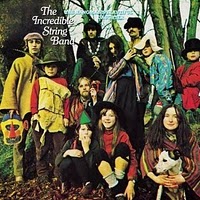 The Hangman’s Beautiful Daughter. Where to start? The lyrics are full of imagination, but almost devoid of sense. In that respect, this is almost the ultimate psychedelic album. Though Heron and Williamson lack the lyricism of Dylan, they come up with some nice music. “Koeeoaddi There” starts the album in classic psychedelic style. There aren’t two related sentences there. Sometimes there aren’t even two related clauses within a sentence. It all becomes too much when Williamson sings ‘Ladybird, ladybird, what is your wish? Your wish is not granted unless it’s a fish’. This is followed by the equally weird “The Minotaur’s Song” which is sung in the style of a Gilbert and Sullivan operetta. The classic line this time: ‘I can’t dream well because of my horns’. The best song is “A Very Cellular Song”. Even this is best appreciated with an unnaturally open mind. It starts off in sort of hazy fairground style, then breaks into a touching spiritual. This is followed by what I can best describe as spoof-baroque. Next is some kind of folk interlude, before the spoof-baroque resumes. The music then takes the back seat as some strange lyrics about slithering and squelching take the foreground. The final section sees a return to fairground music accompanying some mystical mantra or something. Remarkable, but totally bizarre. –Jim
The Hangman’s Beautiful Daughter. Where to start? The lyrics are full of imagination, but almost devoid of sense. In that respect, this is almost the ultimate psychedelic album. Though Heron and Williamson lack the lyricism of Dylan, they come up with some nice music. “Koeeoaddi There” starts the album in classic psychedelic style. There aren’t two related sentences there. Sometimes there aren’t even two related clauses within a sentence. It all becomes too much when Williamson sings ‘Ladybird, ladybird, what is your wish? Your wish is not granted unless it’s a fish’. This is followed by the equally weird “The Minotaur’s Song” which is sung in the style of a Gilbert and Sullivan operetta. The classic line this time: ‘I can’t dream well because of my horns’. The best song is “A Very Cellular Song”. Even this is best appreciated with an unnaturally open mind. It starts off in sort of hazy fairground style, then breaks into a touching spiritual. This is followed by what I can best describe as spoof-baroque. Next is some kind of folk interlude, before the spoof-baroque resumes. The music then takes the back seat as some strange lyrics about slithering and squelching take the foreground. The final section sees a return to fairground music accompanying some mystical mantra or something. Remarkable, but totally bizarre. –Jim
Nektar “Down to Earth” (1974)
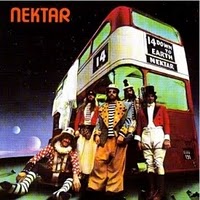 Temporarily abandoning the extended suite forms of their previous releases, Nektar turn in an accessible, almost pop-flavored collection of shorter songs with Down To Earth. Although it orbits in a sort of Euro-hippie galaxy, and features a vague circus concept running throughout, don’t let that scare you away, as this is a focused album with consistently strong songs. My favorites include the giant-sized “Nelly The Elephant,” (which sounds more than a little like part of Pink Floyd’s “Echoes”), animated “That’s Life,” expressive ballad “Little Boy,” and insistent “Show Me The Way,” but even the lesser stuff is pretty great. A refreshing, successful departure from the norm for Nektar. –Ben
Temporarily abandoning the extended suite forms of their previous releases, Nektar turn in an accessible, almost pop-flavored collection of shorter songs with Down To Earth. Although it orbits in a sort of Euro-hippie galaxy, and features a vague circus concept running throughout, don’t let that scare you away, as this is a focused album with consistently strong songs. My favorites include the giant-sized “Nelly The Elephant,” (which sounds more than a little like part of Pink Floyd’s “Echoes”), animated “That’s Life,” expressive ballad “Little Boy,” and insistent “Show Me The Way,” but even the lesser stuff is pretty great. A refreshing, successful departure from the norm for Nektar. –Ben
Henry Cow “Western Culture” (1979)
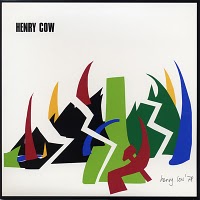 It’s hard to believe this album hit the racks in ’79, a year not known for great prog albums. The closest comparison I can find to Henry Cow would be the Mahavishnu Orchestra, but this being more avant classical in nature. Complex time changes, great playing, and worth it alone for the just the drumming of Chris Cutler, this is an album worth spending hours listening to. Great music. –Brian
It’s hard to believe this album hit the racks in ’79, a year not known for great prog albums. The closest comparison I can find to Henry Cow would be the Mahavishnu Orchestra, but this being more avant classical in nature. Complex time changes, great playing, and worth it alone for the just the drumming of Chris Cutler, this is an album worth spending hours listening to. Great music. –Brian
Nick Drake “Bryter Layter” (1970)
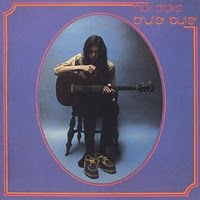 Five Leaves Left was Drake balancing on a wire as lush orchestras complimented bare acoustics with songs that cried in the evening and smiled in the morning. While Pink Moon can be seen as Drake dialed down to -1, Bryter Lyter is Drake turned up to 11. You can hear his smile when he sings on “Hazy Jane II” and you can feel the tears roll on (“Northern Sky”). While the strings on “River Man” and “Cello Song” off his debut added a dramatic flair, the arrangements here added a steady backbone and call for celebration. While the integrity behind the change in sound isn’t that inspiring, the execution is. Who would have known that John Cale of all people who bring the crowning moment of the album when he plays the piano solo in “Northern Sky”? –Allistair
Five Leaves Left was Drake balancing on a wire as lush orchestras complimented bare acoustics with songs that cried in the evening and smiled in the morning. While Pink Moon can be seen as Drake dialed down to -1, Bryter Lyter is Drake turned up to 11. You can hear his smile when he sings on “Hazy Jane II” and you can feel the tears roll on (“Northern Sky”). While the strings on “River Man” and “Cello Song” off his debut added a dramatic flair, the arrangements here added a steady backbone and call for celebration. While the integrity behind the change in sound isn’t that inspiring, the execution is. Who would have known that John Cale of all people who bring the crowning moment of the album when he plays the piano solo in “Northern Sky”? –Allistair
Lucifer’s Friend “Lucifer’s Friend” (1970)
 This German hard rock machine, with British belter John Lawton, (later of Uriah Heep) gave birth to one of the best heavy rock albums of the early 70’s. From the screaming vocals of “Ride In The Sky” (with its brass opening reminiscent of Zeppelin’s “The Immigrant Song” and an almost “thrash metal” riff) to the progressive/hard R&B of “Toxic Shadows”, to the lumbering, Sabbathish doom of “Keep Goin”, this album never lets up for a second. Fans of Black Sabbath, Uriah Heep, Deep Purple and Led Zeppelin must have this in their collection! Lawton is one of the best singers in hard rock, and the musicianship of the group is tremendous. Very heavy indeed for a 1971 release. The bonus tracks show the more mainstream, rock ‘n’ rollin’ side of the band, but the instrumentals “Horla” and “Satyr’s Dance” (taken from B-sides) really cook. Do yourself a large favor and check this one out. —Chris
This German hard rock machine, with British belter John Lawton, (later of Uriah Heep) gave birth to one of the best heavy rock albums of the early 70’s. From the screaming vocals of “Ride In The Sky” (with its brass opening reminiscent of Zeppelin’s “The Immigrant Song” and an almost “thrash metal” riff) to the progressive/hard R&B of “Toxic Shadows”, to the lumbering, Sabbathish doom of “Keep Goin”, this album never lets up for a second. Fans of Black Sabbath, Uriah Heep, Deep Purple and Led Zeppelin must have this in their collection! Lawton is one of the best singers in hard rock, and the musicianship of the group is tremendous. Very heavy indeed for a 1971 release. The bonus tracks show the more mainstream, rock ‘n’ rollin’ side of the band, but the instrumentals “Horla” and “Satyr’s Dance” (taken from B-sides) really cook. Do yourself a large favor and check this one out. —Chris
Budgie “Budgie” (1971)
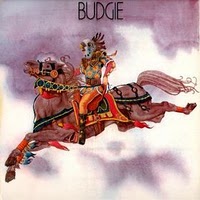 Adopting Black Sabbath’s Master of Reality as a sludgy sonic template while staying grounded in a stomping psych-blues that even in 1971 must have sounded like a bit of a throwback, Budgie are among the truly unsung purveyors of Heavy in its infancy. Like Ozzy Osbourne, Burke Shelley’s voice anticipates the Brit-metal wail that would become a standard—though in Shelley’s case, the sense of adenoidal strain also anticipates Geddy Lee’s shriek, meaning of course that he’s bound to put off a lot of listeners. Me, I think it sounds just fine, a striking counterpoint to the dark mood of the trio’s bottom-heavy music. Derivative moments detract slightly from the proceedings—the middle section of “Nude Disintegrating Parachutist Woman,” for example, is a bit too close to the middle section of Zeppelin’s “Dazed and Confused” for comfort—but on the whole this debut already puts the group in the upper ranks of that early-70s “power trio” sound, and their whimsically silly lyrics are a refreshing change from the pseudo-mystical drama that their counterparts were dealing in. It’s a shame these guys are unknown outside the UK; I have yet to find any of their albums for a reasonable price. So I’m now considering paying unreasonable prices—I like ’em that much. –Will
Adopting Black Sabbath’s Master of Reality as a sludgy sonic template while staying grounded in a stomping psych-blues that even in 1971 must have sounded like a bit of a throwback, Budgie are among the truly unsung purveyors of Heavy in its infancy. Like Ozzy Osbourne, Burke Shelley’s voice anticipates the Brit-metal wail that would become a standard—though in Shelley’s case, the sense of adenoidal strain also anticipates Geddy Lee’s shriek, meaning of course that he’s bound to put off a lot of listeners. Me, I think it sounds just fine, a striking counterpoint to the dark mood of the trio’s bottom-heavy music. Derivative moments detract slightly from the proceedings—the middle section of “Nude Disintegrating Parachutist Woman,” for example, is a bit too close to the middle section of Zeppelin’s “Dazed and Confused” for comfort—but on the whole this debut already puts the group in the upper ranks of that early-70s “power trio” sound, and their whimsically silly lyrics are a refreshing change from the pseudo-mystical drama that their counterparts were dealing in. It’s a shame these guys are unknown outside the UK; I have yet to find any of their albums for a reasonable price. So I’m now considering paying unreasonable prices—I like ’em that much. –Will
Khan “Space Shanty” (1972)
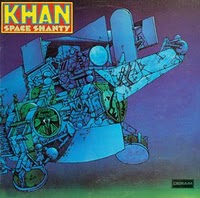 Try as I might I can’t find one flaw on this record. Great prog/space rock from this one album project featuring the amazing instrumentation of Gong’s Steve Hillage (guitar) and Egg’s Dave Stewart (keyboard). On top of all that you get some great songs. Seldom has a forty-five minute album gone by so fast. I’ve got my bags packed and ready to move into this Space Shanty. –Brian
Try as I might I can’t find one flaw on this record. Great prog/space rock from this one album project featuring the amazing instrumentation of Gong’s Steve Hillage (guitar) and Egg’s Dave Stewart (keyboard). On top of all that you get some great songs. Seldom has a forty-five minute album gone by so fast. I’ve got my bags packed and ready to move into this Space Shanty. –Brian


